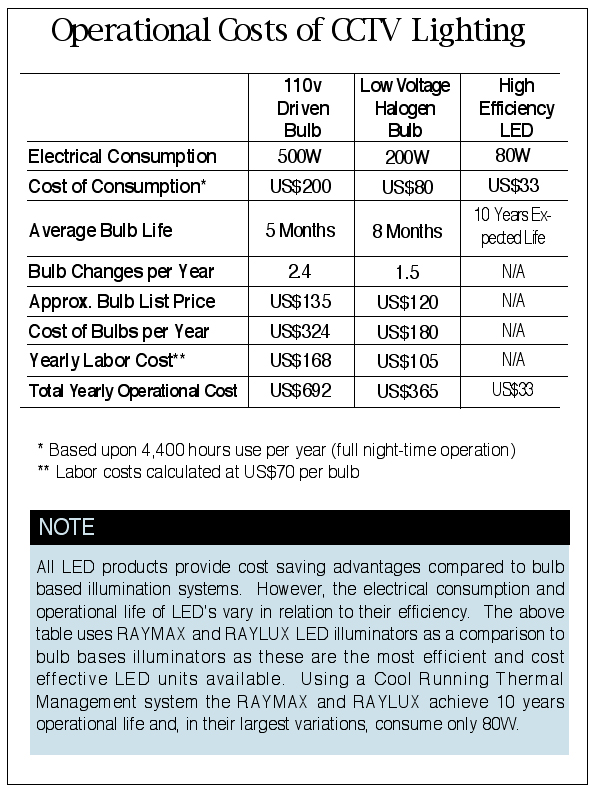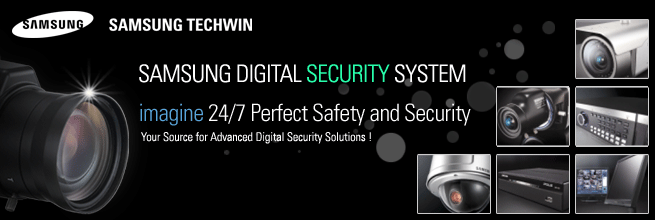By David Lambert
.jpg)
Photo by Raytec
There is no question that LEDs are the future of lighting. Their use has exploded in recent years and even traditional strongholds of the bulb such as car headlights and traffic signs are now adopting LED technology. The key question is why are LEDs the future of Lighting? Simple; it all comes down to two key benefits:
Everyone knows about the long life delivered by LEDs but market understanding of the running and operational costs associated with lighting systems is much lower. LEDs offer significant cost savings to the end user. On CCTV applications using 100 LED illuminators can save the end user up to US$659,000 over a ten year period compared to a traditional 500W illuminator! A saving large enough to convince any end user to use LED illuminators. LEDs also provide increased security. Unlike bulbs they don’t ‘blow’ so if an incident does occur the end user knows that the CCTV illumination will be 100% operational.
This article explains how to calculate the operational costs of your CCTV lighting highlighting the cost savings possible with LED based illuminators. But first, it is essential to understand the fundamental characteristics of LEDs and the predecessors.
SOURCES OF CCTV LIGHT
Incandescent Lamps (including Halogen)
For CCTV purposes, bulb life is limited and they are very inefficient. They are generally expensive to run (typically 500 watts) and expensive to maintain (upto 3 bulb changes per year). End users are increasingly moving away from using halogen based lighting products in favour of longer life LEDs.
Incandescent bulbs were the first bulbs developed and are highly inefficient, wasting 90% of input energy as heat. Their heat output is such that they are extremely hot to touch and can heat surrounding objects in close proximity.
Halogen bulbs provide a minimal increase in efficiency and still waste as much as 85% of input energy as heat. Halogen bulbs are smaller and higher pressure than incandescent bulbs causing halogen bulbs to have an extremely hot surface hazardous to the touch. Bringing the bulb into contact with residue from fingerprints, particularly sodium, may cause bulb failure.
Fluorescent Lamps
Their use for CCTV purposes is limited due to the perceived ‘beating’ effect when used with a CCTV camera. They are generally low power and designed mainly for internal fitting. As they have a large diffused source the light output is difficult to focus and control.
Fluorescent bulbs are much more efficient than incandescent bulbs, operating at approximately 40% efficiency. Only 60% of the input energy is wasted as heat so fluorescent lamps run much cooler than incandescent lamps and can provide equivalent power from much lower electrical input. For this reason, and the fact that fluorescent lamps tend to last 10-20 times as long as an incandescent bulb, they are commonly used in domestic homes as long life bulbs.
However, fluorescent lamps produce a flicker imperceptible to the human eye but visible to cameras as a ‘beat’ effect making fluorescent illumination unsuitable for video surveillance. Fluorescent lamps also contain the hazardous material mercury.
HID Lamps
HID lamps are appropriate for use in CCTV. They are efficient, provide good colour rendition and are long life -- up to 12,000 hours.
High intensity discharge lamps are 60-80% efficient and compared to incandescent and fluorescent lamps provide much more light from a smaller package. HID forms include low pressure sodium (unsuitable for CCTV due to its yellow tinge), high pressure sodium (which is acceptable but produces worse colour rendition than Metal Halide) and Metal Halide. Metal Halide HID bulbs provide a very natural, cool clear White-Light with excellent colour discrimination. HID lamps are commonly used for street lighting and in car headlights.
LEDs
LEDs are the fastest growing lighting solution for CCTV applications. They are extremely efficient and offer unbeatable reliability. LEDs offer the lowest possible running costs (less than 100 watts for highest power units) with the longest operating life (up to 10 years).
Light Emitting Diodes (LEDs) are semiconductors that naturally emit a narrow band of light. They are a relatively new development in lighting but their usage is expanding rapidly on the back of clear technical advantages. LEDs are comparatively expensive to purchase but provide extremely long life up to 100,000 hours. In comparison fluorescent bulbs typically last 10,000 hours and incandescent bulbs 1,000 hours. LED efficiency is typically 80-90% with the greatest efficiency coming from LEDs producing red light. Advantages of LEDs include extremely low electrical consumption, low operating temperatures and continuity of colour through the operating life of the LED. Unlike traditional bulbs LEDs are also highly durable, insensitive to vibration and their hard casing makes them difficult to break. They are also capable of emitting light at a given wavelength without the need for a filter and are quick start devices.
Power management and thermal management are important to ensure LEDs deliver expected performance.
Latest Developments
Through hole LEDs are expensive to mount to PCBs and generally are not as robust as Surface Mount Technology. Surface Mount Technology (SMT) LEDs offer better thermal management and allow the LEDs to be ‘driven’ harder without compromising performance.

CALCULATING THE OPERATIONAL COSTS OF CCTV LIGHTING
Environmental and energy consumption issues are high on the global agenda. Given that US$1 from every US$5 spent globally is used on lighting, and much of this spend is on inefficient or unnecessary lighting, particular attention should be given to this area. The pressure to save energy by looking at running costs will continually increase. Local Authorities and private industry are all looking at methods to save energy costs and lighting is one area due careful attention.
Traditionally lighting (including CCTV lighting) has been provided by mains driven bulbs. Although some bulbs are more efficient than others the future of lighting lies with Light Emitting Diodes (LEDs). Compared to any bulb, LEDs provide significant savings on electrical consumption. LEDs also provide truly long life performance with little ongoing maintenance cost. Table 1 shows the ongoing costs of the RAYMAX and RAYLUX LED illuminators from Raytec compared to standard CCTV illuminators.
COMPARING THE OPERATIONAL COSTS OF CCTV LIGHTING
Table 2 shows the operational costs of using one LED illuminator. Consider the cost savings on larger systems:
EVENT DRIVEN LIGHTING
To further reduce electrical consumption of CCTV lighting installers can consider operating the illumination via either telemetry or PIR event driven alarms. Using event triggered illumination reduces consumption and extends product life. With visible White-Light systems it also helps reduce light pollution.
Whilst Event Driven activation is suitable for LED illumination, it is not always suitable for bulb based CCTV lighting. Turning bulbs on/off regularly puts great pressure on the bulb and may reduce operational life. In addition, event driven illumination is particularly unsuitable for Metal Halide due to the warm up (or strike rate) of the bulb. Event triggered illumination can pro-actively deter the intruder and prevent a crime from taking place. This is particularly useful with White-Light illumination.
Certainly LEDs are the future for CCTV lighting. With modern advances in surface mount technology LEDs can now illuminate vast distances up to 1,000ft.
They provide longer life than traditional bulb solutions and deliver a constantly secure environment. However, the greatest single advantage of LED based CCTV lighting is the huge cost savings they deliver over their operational life. End users are increasingly attracted to these savings and the low maintenance offered by LEDs and installers should tailor their recommendations accordingly to deliver professional, high performance CCTV lighting.
David Lambert is Marketing Director of Raytec (www.RaytecCCTV.com).
For more information, please send your e-mails to swm@infothe.com.
ⓒ2007 www.SecurityWorldMag.com. All rights reserved.
|



